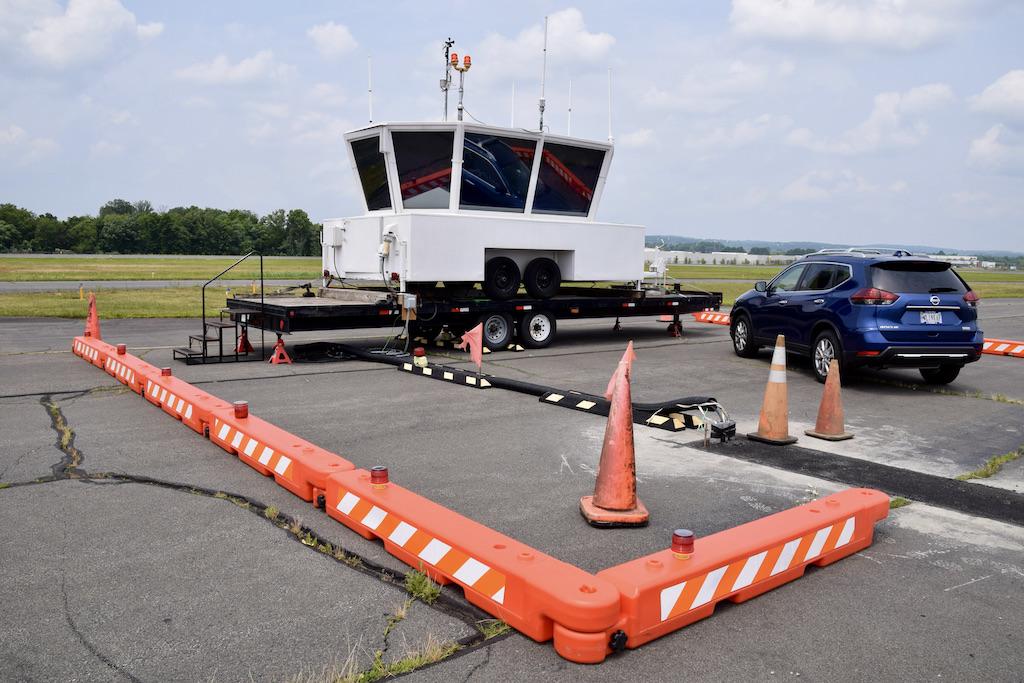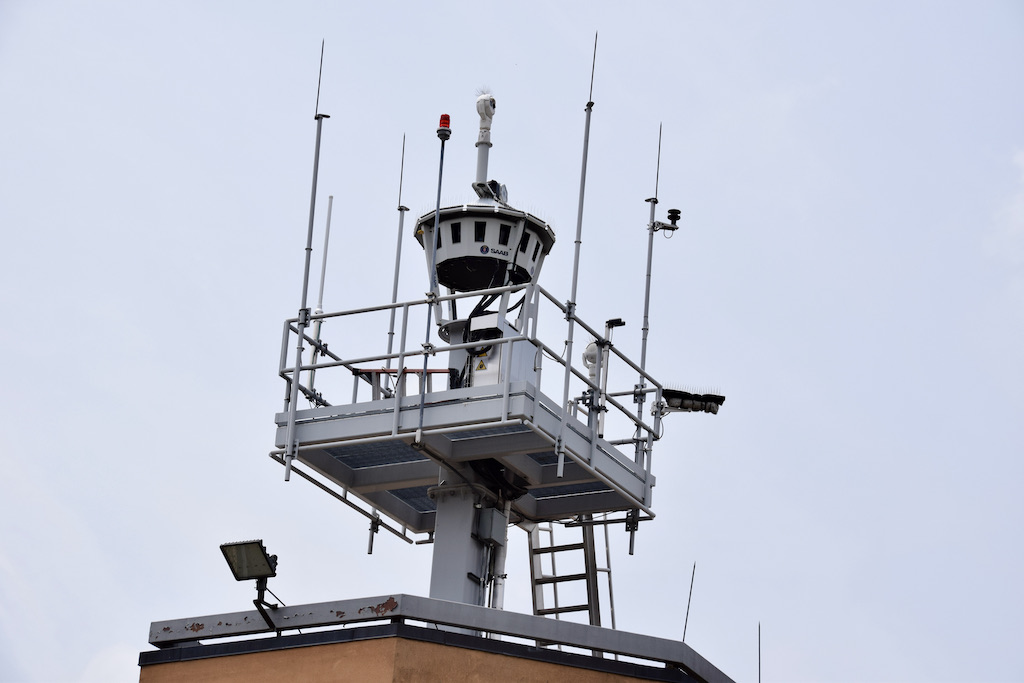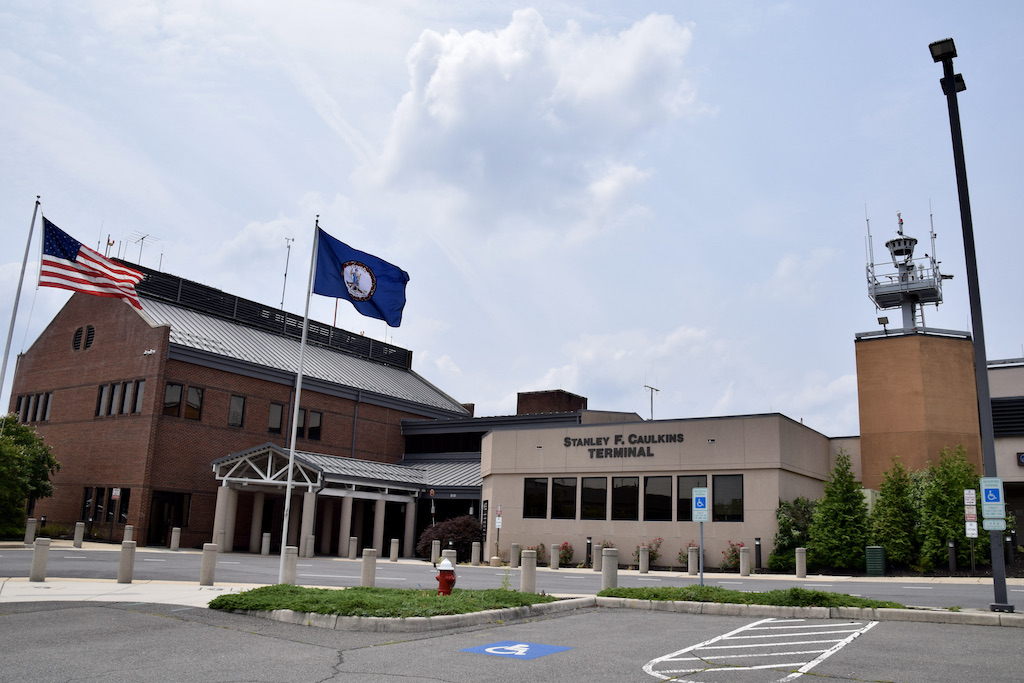
Air traffic services at Leesburg Executive Airport will be provided by this mobile tower platform.
LEESBURG, Virginia – The suburban Washington airport that has served as a testbed for the FAA’s remote tower program will rely on a mobile air traffic control platform for the next few years now that the agency has canceled the testing effort.
Managers at Leesburg Executive Airport (JYO), located 35 mi. northwest of the nation’s capital, expected to begin operating the mobile tower by June 22 after transferring “shout line” communications that had connected the remote tower operating center with the FAA’s Potomac Consolidated Terminal Radar Approach Control (Tracon) and Washington Dulles International Airport tower facilities. Town-owned JYO is designated as a reliever airport for Washington Dulles and lays claim to being the second busiest general aviation airport in Virginia.
The airport expects the mobile platform—a tower cab with radios and weather sensors mounted on a trailer—will stay in place until 2028 when the town hopes to erect a permanent ATC tower. The Leesburg Town Council approved a first, $270,000 outlay for the new tower on June 13 in anticipation of eventually being reimbursed through grants for what could be a $10 million project, the Loudoun Times-Mirror reported.
As with the remote tower center, which was located at a nearby county-owned office building, the mobile tower is staffed by controllers employed by Oklahoma City-based Robinson Aviation through the FAA’s Contract Tower Program. They will provide takeoff and landing guidance at the airport; pilots flying under instrument flight rules must coordinate arrivals and departures with the Potomac Tracon. The mobile tower will operate from 8 a.m. to 6 p.m.
“The remote tower currently has a radar display; the mobile tower will not,” said Airport Director Scott Coffman. “The biggest message our air traffic controllers have gotten out to the public is that [pilots] need to be aware of other aircraft around them because our control tower won’t have radar.”
The low-slung mobile tower is located airside of the terminal building, which is situated at midfield and east of the airport’s single, 5,500-ft. runway. “It’s fairly close to the taxiway,” Coffman said. Controllers “can see the run-up areas, they can see the runway thresholds and the hold-short points. Temporary towers like this are not unusual. There’s one in use in Key West right now; I think their tower was damaged by a hurricane.”
Remote Tower Launch Project

Remote-tower developer Saab, the town of Leesburg and state nonprofit organization Virginia SATSLab launched the remote tower system at JYO in 2014; it became the first project under the FAA’s Remote Tower Pilot Program. Already well under development or operational in Canada, Europe and elsewhere—including at London City Airport since April 2021—remote or digital tower systems use high-resolution cameras and sensors installed at an airport to present a real-time view of airfield activities to controllers based offsite at a remote tower center.
Among benefits, the technology is seen as helping to relieve staffing constraints by enabling controllers to remotely manage operations at multiple airports. It also makes available air traffic services at smaller or remote airports that have no towers.
The FAA declared the remote tower at JYO operationally viable in September 2021, bringing the system one step closer to full certification status. But in February this year, the agency notified Coffman that it planned to stop operating the system by mid-June, a decision it attributed to Saab’s Syracuse-based U.S. subsidiary.
“The company sponsoring the remote tower technology at Leesburg Executive Airport decided not to continue the systems design approval process,” the agency said in a statement provided to BCA. “The remote tower in Leesburg is part of a test program. The FAA cannot allow the use of an unapproved system in the National Airspace System. It creates a safety risk.”
Saab in response said: “Since 2018, the tower has been safely operating with FAA approval and without any errors or outages. In 2021, the FAA published a new certification process, and Saab has been working to meet these requirements ever since. Unfortunately, we recently determined there is no reasonable path forward for approval of the JYO system under these new requirements and informed the FAA that Saab can no longer pursue the extended process.”
The FAA’s surprise decision generated a “huge outcry” from the community, Coffman said, including from pilots and lawmakers in Congress. Industry also rallied behind the airport. NBAA President and CEO Ed Bolen wrote a letter in early April to acting FAA Administrator Billy Nolen, urging the agency to work with Leesburg “to explore alternatives” to canceling the remote tower. (Nolen has since left the FAA and now works as chief safety officer for Archer Aviation.)
“It is concerning that over a dozen safety assessments, an operational viability decision and years of operational experience, as well as robust investments by the FAA and industry, are being discarded and services will come to an end on the cusp of a busy summer travel season,” Bolen wrote.
Under a resolution with the FAA that Coffman briefed to the town council, the agency will cover the cost of leasing the mobile tower through September, after which Leesburg will rent the structure for $10,000 a month. The FAA agreed to pay controllers’ salaries through September 2028, when the expectation is that a permanent tower will be erected with grant money. It also agreed to install a STARS radar display in the mobile facility, as was provided in the remote tower center.
“The biggest concern was that the FAA initially said they wanted to remove all tower services at the airport and go back to an uncontrolled airport,” Coffman said. “That’s what our pilots were most concerned about. To run 80,000 operations a year at a general aviation airport in the nation’s capital without a tower would be detrimental to business at the airport, it would reduce capacity, it would be tough.”
He said his understanding is that the FAA wants to base remote tower testing at the agency’s William J. Hughes Technical Center near Atlantic City, New Jersey, before releasing systems into the national airspace system.
An Uncertain Future

The experience of JYO also brought attention to a second FAA-sponsored remote tower at Northern Colorado Regional Airport (FNL) in Loveland, Colorado. Late last year, the FAA required contractor Searidge Technologies of Ottawa, Canada, to make modifications to its system, including to improve the visual acuity of its 1080p cameras and displays.
In response to an inquiry, Searidge said its remote tower system at FNL “is currently in a state of modernization” to meet FAA operational visual requirements (OVR) and system requirements “that began evolving in 2019, and for which the FAA released the most recent versions in January and February 2023, respectively.”
The company said it demonstrated the system with higher-resolution 4K cameras and displays in May, proving that it can satisfy the latest FAA OVR requirements. It added, however, that “Searidge is still learning more about the FAA’s evolving validation and certification process.”
The sensor stack of Saab’s remote tower system, installed atop the terminal building at JYO, was still in place when BCA visited the airport. The remote tower system had actively managed air traffic there from 2018 until this spring. During that time, traffic grew by nearly half—from 55,000 operations (takeoffs and landings) in 2019 to 77,000 operations in 2021, during the Covid 19 pandemic.
Operations declined to 74,000 in 2022 but so far this year are running 23% higher year-over-year, Coffman said. Last July, a second FBO, Kuhn Aviation, joined ProJet Aviation as a fuel and service provider. There are 260 based aircraft at JYO and more than 130 hangars, all of which are occupied, with a wait list.
The remote tower system helped underpin the airport and regional economy, Coffman said. “Remote tower was a real success story of local, state, federal and private business all working together on a project that would reduce costs and improve safety,” he observed. “Even though the system didn’t pan out here at Leesburg, I think there is a future for remote towers in the U.S.”





